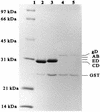Use of epitope mapping to identify a PCR template for protein amplification and detection by enzyme-linked immunosorbent assay of bovine herpesvirus type 1 glycoprotein D
- PMID: 12409372
- PMCID: PMC139723
- DOI: 10.1128/JCM.40.11.4045-4050.2002
Use of epitope mapping to identify a PCR template for protein amplification and detection by enzyme-linked immunosorbent assay of bovine herpesvirus type 1 glycoprotein D
Abstract
Infection with bovine herpesvirus type 1 (BHV-1) occurs worldwide and causes serious economic losses due to the deaths of animals, abortions, decreased milk production, and loss of body weight. BHV-1 is frequently found in bovine semen and is transmitted through natural service and artificial insemination. The detection of BHV-1 in bovine semen is a long-standing problem in veterinary virology which is important in disease control schemes. In the present study, ordered deletions of the full-length BHV-1 glycoprotein open reading frame were used to identify an epitope recognized by a specific monoclonal antibody (MAb). A glycoprotein D fragment containing this epitope was then amplified using an in vitro protein amplification assay developed previously (J. Zhou, J. Lyaku, R. A. Fredrickson, and F. S. Kibenge, J. Virol. Methods 79:181-189, 1999), and the resulting peptide was detected by indirect enzyme-linked immunosorbent assay (ELISA) with the specific MAb. This method detected 0.0395 50% tissue culture infective dose of BHV-1 in raw bovine semen, which was 1,000-fold more sensitive than traditional PCR. We therefore conclude that this in vitro protein amplification assay combined with ELISA has superior sensitivity for direct virus detection in clinical samples.
Figures





Similar articles
-
Improved detection of bovine herpesvirus 1 in artificially infected bovine semen by protein amplification.J Virol Methods. 1999 May;79(2):181-9. doi: 10.1016/s0166-0934(99)00025-7. J Virol Methods. 1999. PMID: 10381088
-
Detection of bovine herpesvirus-1 infection in breeding bull semen by virus isolation and polymerase chain reaction.Rev Sci Tech. 2005 Dec;24(3):1085-94. Rev Sci Tech. 2005. PMID: 16642777
-
Rapid detection of bovine herpesvirus 1 in the semen of infected bulls by a nested polymerase chain reaction assay.Can J Vet Res. 1996 Apr;60(2):100-7. Can J Vet Res. 1996. PMID: 8785714 Free PMC article.
-
Detection of bovine herpesvirus 1 (BHV-1) genomic sequences in bovine semen inoculated with BHV-1 by polymerase chain reaction.Acta Virol. 1997 Dec;41(6):311-5. Acta Virol. 1997. PMID: 9607088
-
Identification of an epitope within the Bovine herpesvirus 1 glycoprotein E cytoplasmic tail and use of a monoclonal antibody directed against the epitope for the differentiation between vaccinated and infected animals.J Virol Methods. 2016 Jul;233:97-104. doi: 10.1016/j.jviromet.2016.02.012. Epub 2016 Mar 11. J Virol Methods. 2016. PMID: 26976821
Cited by
-
Mapping a highly conserved linear neutralizing epitope on gD glycoprotein of bovine herpesvirus type I using a monoclonal antibody.J Vet Med Sci. 2019 May 31;81(5):780-786. doi: 10.1292/jvms.19-0041. Epub 2019 Mar 27. J Vet Med Sci. 2019. PMID: 30918137 Free PMC article.
References
-
- Abdelmagid, O. Y., H. C. Minocha, J. K. Collins, and S. I. Chowdhury. 1995. Fine mapping of bovine herpesvirus-1 (BHV-1) glycoprotein D (gD) neutralizing epitopes by type-specific monoclonal antibodies and sequence comparison with BHV-5 gD. Virology 206:242-253. - PubMed
-
- Abdelmagid, O. Y., M. M. Mansour, O. Okwumabua, and L. van Drunen. 1998. Expression and cellular distribution of baculovirus-expressed bovine herpesvirus 1 (BHV-1) glycoprotein D (gD) sequences. Arch. Virol. 143:2173-2187. - PubMed
-
- Crowther, J. R. 2000. Validation of diagnostic tests, p. 311-313. In J. M. Walker (ed.), The ELISA guidebook. Humana Press, Totowa, N.J.
-
- Dubuisson, J., B. A. Israel, and G. J. Letchworth. 1992. Mechanisms of bovine herpesvirus type 1 neutralization by monoclonal antibodies to glycoproteins gI, gIII and gIV. J. Gen. Virol. 73:2031-2039. - PubMed
-
- Favre, D. 1992. Improved phenol-based method for the isolation of DNA fragments from low melting temperature agarose gels. BioTechniques 13:120-123. - PubMed
Publication types
MeSH terms
Substances
LinkOut - more resources
Full Text Sources

